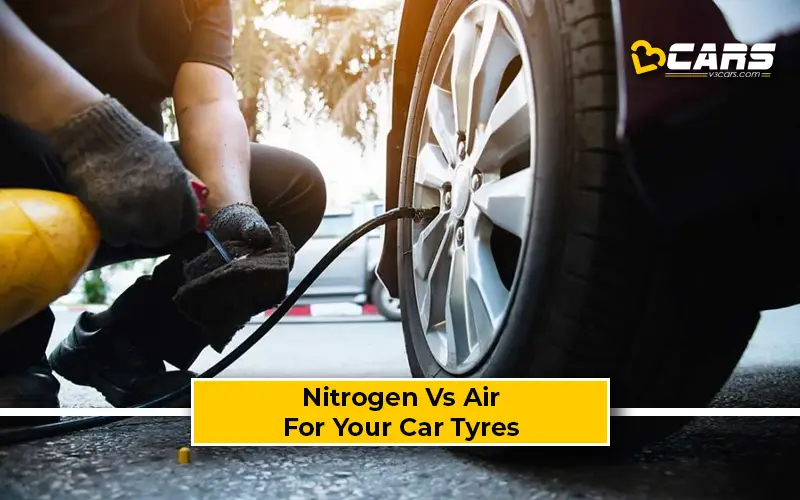Nitrogen Vs Air In Car Tyres: Pros And Cons - Car Guide
Choosing the right type of inflation for your car tyres is crucial to ensure optimal performance and safety on the road. While traditional air has been the go-to choice for decades, nitrogen inflation has gained popularity in recent years. This article will explore the pros and cons of using nitrogen versus air in car tyres, shedding light on the key factors to consider when making an informed decision.

Pros of Using Nitrogen in Car Tyres
- Improved Tyre Pressure Stability: Nitrogen molecules are larger than oxygen molecules found in regular air. This leads to reduced permeation, meaning that nitrogen-filled tyres tend to maintain their pressure for a longer period. Maintaining the correct tyre pressure not only enhances fuel efficiency but also ensures even tread wear, promoting safety and prolonging the life of your tyres.
- Reduced Oxidation and Corrosion: Nitrogen is an inert gas, which means it does not readily react with other substances. This property reduces the risk of oxidation and corrosion within the tyre, particularly for steel wheels. By minimising internal damage, nitrogen inflation can extend the lifespan of your wheels, saving you money on costly repairs or replacements.
- Enhanced Fuel Efficiency: Maintaining optimal tyre pressure is crucial for maximising fuel efficiency. Nitrogen-filled tyres tend to have more consistent pressure, resulting in improved fuel economy. With better mileage, drivers can save money on fuel costs in the long run while reducing their carbon footprint.
- Temperature Stability: Nitrogen has a lower moisture content compared to regular air. This lower moisture content translates to reduced fluctuations in tyre pressure due to temperature changes. Consequently, nitrogen-filled tyres are more likely to maintain stable pressure levels, providing predictable handling and thus, better safety on the road.
Also Read: Projector Headlamps – Feature Explained
Cons of Using Nitrogen in Car Tyres
- Limited Accessibility: Unlike regular air, which is readily available at any petrol pump, finding a nitrogen refill station may be a challenge in some areas. While the popularity of nitrogen inflation is growing, it is not as widely accessible as traditional air.
- Cost Factor: Nitrogen inflation often comes with a cost, as it requires specialised equipment and additional maintenance. The initial cost of nitrogen filling is higher than using regular air.
- Minor Performance Difference: While the benefits of nitrogen inflation are well-documented, the actual performance difference between nitrogen and air in day-to-day driving conditions may be minimal and not even noticeable to most drivers. The advantages of nitrogen inflation are most noticeable in extreme conditions, such as high-performance racing or commercial applications that demand precision handling and stability.
- No Way To Verify Nitrogen Content: While most petrol pumps these days have both air and nitrogen compressors, there is no way to verify the nitrogen content while filling your tyres. Most tyre shops charge anywhere from Rs. 80 to Rs. 200 per tyre for nitrogen. Thus, if you paid for nitrogen but the concentration of nitrogen in the air that is filled into your car’s tyre is low, you are staring at a loss of Rs. 400 to Rs. 1,000 for a complete set of tyres including the spare wheel.
Also Read: Tilt And Telescopic Steering Wheel – Feature Explained
Pros of Using Regular Air in Car Tyres:
- Accessibility: Regular air is widely available at petrol pumps, making it convenient for drivers to maintain proper tyre pressure whenever needed. No specialised equipment or additional costs are required.
- Affordability: Regular air is free or available at a minimal cost at most petrol pumps. This makes it a cost-effective option for maintaining proper tyre inflation.
- Common Compatibility: Standard tyres are designed to work well with regular air. They are built to handle the properties of air, including its composition and moisture content.
- Minimal Performance Difference: In everyday driving conditions, the performance difference between regular air and nitrogen may not be significant for the average driver. Most drivers can achieve satisfactory handling, traction, and fuel efficiency with properly inflated tyres using regular air.
- Normal Air Is 78% Nitrogen: Nitrogen makes up about 78% of air while oxygen is the second most abundant gas in air at 21%. Even in the best case scenario, you're paying a premium to get about 15% better nitrogen concentration as typically it's already close to 80% in air. Obviously you shouldn't expect 100% pure nitrogen as there are no severe risks associated with nominal dilution.
Also Read: How To Find Tata Car Manufacturing Date With VIN
Cons of Using Regular Air in Car Tyres
- Pressure Loss Over Time: Regular air tends to permeate through the tyre rubber more quickly than nitrogen. As a result, tyre pressure can gradually decrease over time, requiring more frequent checks and adjustments.
- Moisture Content: Regular air contains moisture, which can lead to fluctuations in tyre pressure due to temperature changes. This can affect handling and stability in extreme weather conditions.
- Corrosion and Oxidation: The presence of moisture in regular air can contribute to corrosion and oxidation within the tyre and rim. Over time, this can lead to damage, potentially reducing the lifespan of the tyres and wheels.
- Inconsistent Pressure: The moisture content and composition of regular air can cause pressure fluctuations, especially during temperature changes. This inconsistency may affect handling and performance, particularly in situations that demand precise control.
Also Read: Cruise Control – Feature Explained
Conclusion
Regular air remains a popular choice for tyre inflation due to its accessibility, affordability, and compatibility with standard tyres. While the performance difference between regular air and nitrogen may be minimal for everyday driving, drivers should regularly monitor and adjust their tyre pressure to ensure optimal performance and safety on the road.
We recommend using a tyre pressure monitoring system (TPMS) to keep an eye on your car’s tyre pressures and fill up when the pressure goes down below the manufacturer’s recommendations that can be found on the driver’s door or owner’s manual. Do NOT keep driving around town on low tyre pressure because you can’t find a nitrogen filling station nearby. If required, you can top up your tyres with regular compressed air even if your tyres were filled with nitrogen previously.
Nitrogen inflation is a race-derived technology and a “want” created by companies that profit from it. If you are hellbent on spending money for nitrogen, remember that in the best case, you are paying for 15% better concentration of nitrogen than air. In the worst cae, you are paying for absolutely nothing.
Note: Check your Car EMI with our - Car Loan EMI Calculator
You can use our Fuel Cost Calculator to see how much any petrol, diesel or CNG car will cost to run based on the latest fuel price in your city.



0 Comments